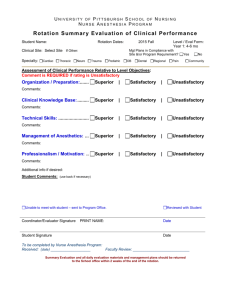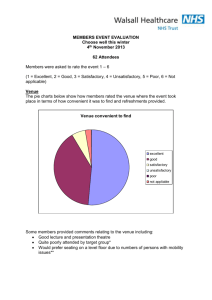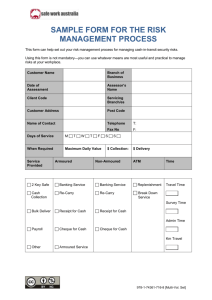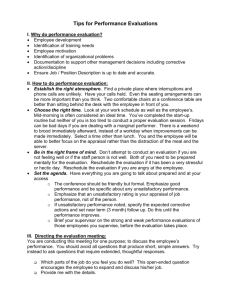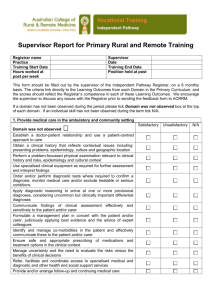Report of the Greater Manchester/Lancashire/PHLS Liaison Group
advertisement
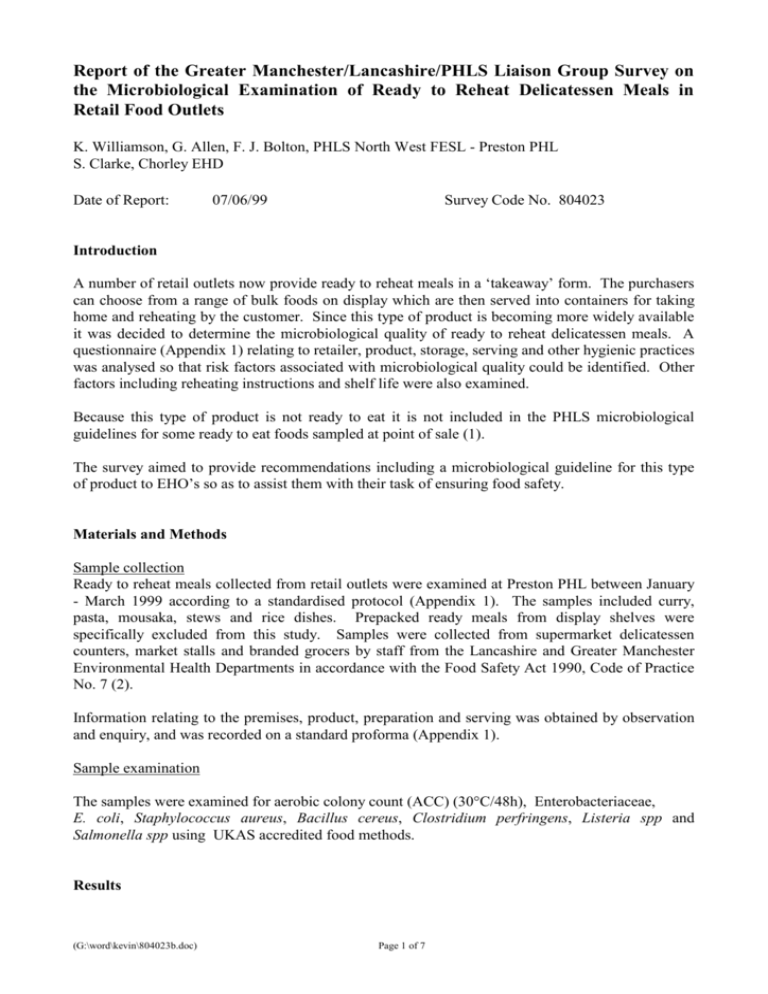
Report of the Greater Manchester/Lancashire/PHLS Liaison Group Survey on the Microbiological Examination of Ready to Reheat Delicatessen Meals in Retail Food Outlets K. Williamson, G. Allen, F. J. Bolton, PHLS North West FESL - Preston PHL S. Clarke, Chorley EHD Date of Report: 07/06/99 Survey Code No. 804023 Introduction A number of retail outlets now provide ready to reheat meals in a ‘takeaway’ form. The purchasers can choose from a range of bulk foods on display which are then served into containers for taking home and reheating by the customer. Since this type of product is becoming more widely available it was decided to determine the microbiological quality of ready to reheat delicatessen meals. A questionnaire (Appendix 1) relating to retailer, product, storage, serving and other hygienic practices was analysed so that risk factors associated with microbiological quality could be identified. Other factors including reheating instructions and shelf life were also examined. Because this type of product is not ready to eat it is not included in the PHLS microbiological guidelines for some ready to eat foods sampled at point of sale (1). The survey aimed to provide recommendations including a microbiological guideline for this type of product to EHO’s so as to assist them with their task of ensuring food safety. Materials and Methods Sample collection Ready to reheat meals collected from retail outlets were examined at Preston PHL between January - March 1999 according to a standardised protocol (Appendix 1). The samples included curry, pasta, mousaka, stews and rice dishes. Prepacked ready meals from display shelves were specifically excluded from this study. Samples were collected from supermarket delicatessen counters, market stalls and branded grocers by staff from the Lancashire and Greater Manchester Environmental Health Departments in accordance with the Food Safety Act 1990, Code of Practice No. 7 (2). Information relating to the premises, product, preparation and serving was obtained by observation and enquiry, and was recorded on a standard proforma (Appendix 1). Sample examination The samples were examined for aerobic colony count (ACC) (30°C/48h), Enterobacteriaceae, E. coli, Staphylococcus aureus, Bacillus cereus, Clostridium perfringens, Listeria spp and Salmonella spp using UKAS accredited food methods. Results (G:\word\kevin\804023b.doc) Page 1 of 7 A total of 262 ready to eat meals were submitted and examined from 25 out of the 26 authorities in Greater Manchester and Lancashire as detailed in Appendix 1. Microbiological results The microbiological results are summarised in Table 1. Table 1. Microbiology results of ready to reheat delicatessen meals (n = 262). Detected ACC Enterobacteriaceae E.coli S.aureus B.cereus C.perfringens Listeria spp Salmonella spp Not detected <10 <20 <102 10-<102 20-<102 24 112 50 3 - 258 258 258 260 1 258 0 2 102-<103 103-<104 104-<105 105-<106 106-<107 >107 28 50 4 4 1 2 56 23 - 72 17 1 - 35 9 - 27 - 20 1 - 262 The results were assessed using Categories 2, 3 and 4 of the PHLS microbiological guidelines for some ready to eat foods (1) and the Preston PHL proposed guidelines for Enterobacteriaceae (3). The results are summarised in Table 2. Table 2. Microbiological quality of ready to reheat delicatessen meals using Categories 2, 3 and 4 (2) and (3) (n = 262) Category 2 applied Category 3 applied Category 4 applied Table 3. Satisfactory (%) 101 (39) 161 (62) 181 (69) Borderline (%) 75 (29) 45 (17) 44 (17) Unsatisfactory (%) 85 (32) 55 (21) 36 (18) Unacceptable 1 1 1 Key to classification (1). Microbiological parameter Aerobic Colony Count; Food category 2 Food category 3 Food category 4 Enterobacteriaceae* E. coli S. aureus B. cereus Listeria spp. C. perfringens Salmonella spp. (G:\word\kevin\804023b.doc) Microbiological quality (cfu/g unless stated) Borderline - limit Satisfactory of acceptability Unsatisfactory <104 <105 <106 <5.0 x 102 <20 <20 <103 <20 <10 Not detected in 25g 104 - <105 105 - <106 106 - <107 5.0 x 102 - <104 20 - <102 20 - <102 103 - 104 20 - <102 10 - <102 Page 2 of 7 105 106 107 104 102 - <104 102 - <104 104 - 105 102 - <104 102 - <104 Unacceptable/ potentially hazardous N/A N/A N/A N/A 104 104 105 104 104 Detected in 25g N/A = Not applicable * = Preston PHL proposed microbiological guidelines (2) From these results it is recommended that the PHLS guidelines for some ready to eat foods (1) and in particular Category 3 for the ACC, and the Preston PHL proposed guidelines for Enterobacteriaceae (3) should be used to assess ready to reheat delicatessen meals. Based on the Category 3 guideline, 161 (62%) of the samples were satisfactory, 45 (17%) borderline, 55 (21%) unsatisfactory and 1 (<1%) samples were of unacceptable quality. The ACC was the microbiological parameter most often associated with unsatisfactory results accounting for 47 of the 56 unsatisfactory/unacceptable samples. The remainder (unsatisfactory results not due to ACC) were caused by the presence of Enterobacteriaceae (4; 14%) in excess of 104 cfu/g, Staphylococcus aureus (4; 14%) and Clostridium perfringens (1; 2%) in excess of 100 cfu/g. There was only one unacceptable result due to a high level ( 104 cfu/g) of E. coli. This sample was also unsatisfactory for ACC and Enterobacteriaceae. Enterobacteriaceae at unsatisfactory levels i.e. at or greater than 104 cfu/g were present in 27 (10%) samples. Low numbers of unsatisfactory results due Staphylococcus aureus, Bacillus cereus, Clostridium perfringens and Listeria spp. were obtained as demonstrated in Table 1. Significantly only one sample produced an unsatisfactory level of E. coli. Salmonella spp. was not detected in any of the samples. Questionnaire results Questionnaire results were analysed in relation to microbiological quality when relevant. A copy of the questionnaire is available in Appendix 1. Q.1 The majority of samples, 227 (87%) were collected from supermarkets and 23% of these gave unsatisfactory results, 61% satisfactory results. There were too few samples from other premises to comment. Q.2, Q.3 The majority of meals examined 165 (63%) were meat and 21% of these gave unsatisfactory results and 61% gave satisfactory results. Eighty-nine vegetable meals including rice and pasta produced 22% unsatisfactory and 63% satisfactory results. The main ingredient was indicated for 255 of the meals. Chicken was the most common meat ingredient and was included in 97 samples (38%). These samples produced 29 (30%) unsatisfactory and 48 (49%) satisfactory results. Rice was the most common non meat main ingredient and was included in 63 samples (24%). These samples produced 15 (24%) unsatisfactory and 36 (57%) satisfactory results. Q.4 The majority (91%) of the meals were not made on the premises. Q.5, Q.6 The majority (94%) of the bulk product was stored chilled, and 6% frozen. (G:\word\kevin\804023b.doc) Page 3 of 7 A dedicated fridge/freezer was used to store 80% of the meals. Of these 22% gave unsatisfactory results and 60% were satisfactory. Of the 20% not stored in a dedicated fridge/freezer 22% gave unsatisfactory results and 66% were satisfactory. Q.7, Q.8, Q.9 Cleaning procedures for 257 display areas were checked and all were satisfactory and appeared clean. The temperature of a relevant food product in 250 display units was recorded. A total of 200 (80%) samples were collected form chill displays at <5°C. Of these 46 (23%) were unsatisfactory and 117 (58%) satisfactory. Fifty (20%) samples were obtained from chill displays at 5-8°C. Of these 9 (18%) were unsatisfactory and 34 (68%) satisfactory. No food products were found to be stored at >8°C in this study. Q.10, Q.11, Q.16, Q.17 Information on the type of container used for display was available for all 262 samples. The majority of samples (202: 77%) were in reusable containers and the remaining 60 (23%) were in disposable containers. Of the 202 samples in reusable containers 51 (25%) produced unsatisfactory and 106 (52%) satisfactory results. Of the 60 samples in disposable containers, 4 (7%) produced unsatisfactory and 51 (85%) satisfactory results. Most of the reusable display containers (192; 95%) were washed between display periods. The same display container was used throughout the serving period at 62% of the premises visited. Of these 20% produced unsatisfactory and 66% satisfactory results. Of the 98 (38%) containers which were changed during the serving period 23% produced unsatisfactory and 55% satisfactory results. Residual food in 55% of the display containers was discarded at the end of the serving period. Of these (19%) produced unsatisfactory and 60% satisfactory results. Residual food in 45% of the display containers was not discarded at the end of the serving period. 24% of these produced unsatisfactory and 60% satisfactory results. Q.12 The product shelf life following initial display was obtained for 244 samples and is summarised below. 1 day 2 days 3 days 4 days >4 days 59 (24%) 88 (36%) 45 (18%) 23 (10%) 29 (12%) Q.13, Q.14, Q.15 Of the 141 (54%) of meals served in foil containers, 18% produced unsatisfactory results and 60% satisfactory. (G:\word\kevin\804023b.doc) Page 4 of 7 Of the 43 (16%) meals served in polystyrene containers 26% produced unsatisfactory results and 63% satisfactory. The majority, 96% of meals were served using dedicated utensils. Information relating to delicatessen serving staff also handling raw foods was obtained for 255 staff. Of these 70 (27%) also handled raw foods, and 183 (73%) did not. Of the 70 staff who also handled raw food, 26% of the delicatessen meals produced unsatisfactory results and 61% satisfactory. Of the 185 staff who never handled raw foods, 20% of the delicatessen meals produced unsatisfactory results and 61% satisfactory. Q.18, Q.19, Q.20 The following information was obtained in relation to instructions given with the takeaway product. Were reheating instructions provided? (n = 261) Written 208 (80%) Verbal 6 (2%) None 47 (18%) Were domestic storage instructions provided? (n = 261) Written 139 (53%) Verbal 3 (1%) None 119 (46%) Was a ‘use by’ time specified (n = 260) Written 203 (78%) Verbal 3 (1%) None 54 (21%) Conclusions 1. Category 3 of the PHLS microbiological guidelines for some ready to eat foods (2) and the Preston PHL proposed guidelines for Enterobacteriaceae (3) are recommended for assessing the microbiological quality of ready to reheat delicatessen meals. 2. Overall the microbiological quality of this type of product, sampled in the survey was good with only one sample giving an unsatisfactory level of E. coli. The potential foodborne pathogens, Staphylococcus aureus, Bacillus cereus, Clostridium perfrigens and Listeria spp present in a small number of samples were all detected at <1000/g. Salmonella was not detected in any of the samples. 3. Hygiene practices associated with the meals sampled in this survey i.e. use of dedicated storage conditions, display temperatures, dedicated serving utensils, cleaning procedures etc. were good. (G:\word\kevin\804023b.doc) Page 5 of 7 4. The use of disposable display containers produced meals of better microbiological quality than those from the reusable containers. However, only 23% of the meals were stored in disposable containers. 5. A surprisingly high number of delicatessen serving staff also handled raw products (27%). Meals served by these staff produced a higher number of unsatisfactory results than the meals served by dedicated delicatessen staff. 6. Consumer information was not provided with all of the meals. Reheating instructions were not provided for 18% of the meals purchased, the use by date was not specified for 21% and domestic storage instructions were not provided for 46% of the samples. 7. The shelf life following initial display was 4 days for 22% of the products. The age of the product was not specified in this survey and the conclusions are therefore drawn from samples at different stages of their shelf life. It may be useful to carry out further studies on ready to reheat meals 4 days after initial display. References (1) PHLS. 1996. Microbiological guidelines for some ready-to-eat foods sampled at the point of sale - an expert opinion from the PHLS. PHLS Microbiological Digest. 13: 41-43. (2) Ministry of Agriculture, Fisheries and Food. Department of Health, Food Safety Act 1990, Code of Practice No. 7: Sampling for Analysis and Examination. 1990. London. HMSO. (3) Suggested guidelines for Enterobacteriaceae counts in food samples. G. Allen, F. J. Bolton, K. Williamson Preston PHL. PHLS Annual Scientific Meeting September 1998, Poster presentation. (G:\word\kevin\804023b.doc) Page 6 of 7 APPENDIX 1 No. of pages (A) Protocol (1 - 3) Available on request (B) Questionnaire (1) (C) Survey participants (1) (G:\word\kevin\804023b.doc) Page 7 of 7

